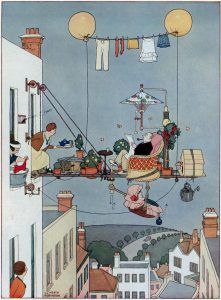David Bennun in More Intelligent Life:
 It’s one thing for an artist to establish a reputation, another for them to enter the dictionary. When the British want to describe a whimsical, improvised or over-elaborate mechanism, they call it a “Heath Robinson” machine, after the drawings of William Heath Robinson. (Americans have a direct equivalent in Rube Goldberg, whose creations, inspired by similar rapid changes in society and technology, are remarkably similar to those of his British counterpart.) A new exhibition of Heath Robinson’s work shows how he became a household name, in more ways than one.
It’s one thing for an artist to establish a reputation, another for them to enter the dictionary. When the British want to describe a whimsical, improvised or over-elaborate mechanism, they call it a “Heath Robinson” machine, after the drawings of William Heath Robinson. (Americans have a direct equivalent in Rube Goldberg, whose creations, inspired by similar rapid changes in society and technology, are remarkably similar to those of his British counterpart.) A new exhibition of Heath Robinson’s work shows how he became a household name, in more ways than one.
…“Heath Robinson’s Home Life”, at the museum dedicated to him in the north London suburb of Pinner, where he lived, focuses on the work that cemented his fame: the fantastical illustrations of domestic scenes that he drew for magazines and books from the 1920s until his death in 1944. Heath Robinson was inspired by the rapid expansion of housing in interwar Britain. In the cities, blocks of flats were springing up, and suburbs – fed by new transport links and the rise in car ownership – were mushrooming. In total, 4.5m new homes were built in the 1920s and 1930s, and in London, by the start of the second world war, more flats than houses were being constructed. This period of transformation provided Heath Robinson with ample opportunity for satire. With a keen eye on the market, he collaborated with writer K.R.G. Browne on a bestselling series of spoof advice books, including “How To Live In A Flat” (1936), “How To Be A Perfect Husband” (1937) and “How To Be A Motorist” (1939). His wry yet affectionate pictures suggest he – like many other people in Britain – regarded the workings of this new era with a certain scepticism, yet also with considerable enthusiasm. To Heath Robinson, as to his many admirers, his was an age of both absurdity and wonder.
More here.
